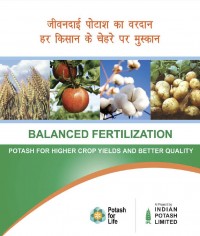Publications
- Potash fertilization for enhancing the productivity of pearlmillet-safflower sequence under dryland condition
- Large-scale demo plot trial project of potash fertilization for increased yield and profitability for smallholder soybean fields in India
- Response in Maize to Applied Potassium: Results from Field Demonstrations in the States of Andhra Pradesh, Chhattisgarh and Maharashtra
- Effect of Potash Fertilization on Potato Yields in States of West Bengal and Jammu & Kashmir
- Fertilizing Indian Rice Plots with Potash
- Assessing the Impact of Balanced Use of Inorganic Fertilizers in Rice-Wheat Cropping System in Bihar
- The Impact of Potassium Fertilization on Sugarcane Yields: A Comprehensive Experiment of Pairwise Demonstration Plots in Uttar Pradesh, India
- Benefits of Potash Fertilization in Rice in Six States of India – Results from Field Demonstrations
- Potash for Life – India, Since 2013
- Nutrition and Health – the Importance of Potassium (in Hindi)
- Potassium – a Nutrient Essential for Life (in Hindi)
- Potassium – the Quality Element in Crop Production (in Hindi)
- Deficiency Poster for Andhra Pradesh
- Tomato brochure for Maharashtra
- Sunflower brochure for Maharashtra
- Sugarcane brochure for Maharashtra
- Soyabean brochure for Maharashtra
- Sorghum brochure for Maharashtra
- Pomegranate brochure for Maharashtra
- Onion brochure for Maharashtra
- Maize brochure for Maharashtra
- Rice brochure for Karnataka
- Potash for Life infographic – results of the first season
- Potash for Life
- Balanced fertilization
- Potash for Life – first season summary
- Apple brochure
- Stone Fruit brochure
- Vegetables brochure
- Sunflower brochure

Balanced fertilization
What is Balanced Fertilization? Crops need many essential nutrients for optimum growth, yield and quality.
Nitrogen (N), phosphorus (P), potassium (K), sulphur and zinc are some of the essential plant nutrients. Crops need N, P and K in large amounts, hence these are applied through fertilizers. Application of plant nutrients in optimum ratio and adequate amounts is called “Balanced Fertilization” and is outlined in this publication.




